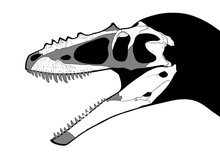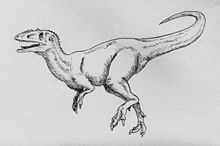Alioramus
| Alioramus Temporal range: Late Cretaceous,
| |
|---|---|

| |
| Scientific classification | |
| Kingdom: | |
| Phylum: | |
| Class: | |
| Superorder: | |
| Order: | |
| Suborder: | |
| Family: | |
| Genus: | Alioramus Kurzanov, 1976
|
| Species | |
| |
Alioramus (Template:PronEng; meaning 'different branch') is a genus of tyrannosaurid theropod dinosaur from the Late Cretaceous period of Asia. The type and only species, A. remotus, is known from a partial skull and three metatarsals recovered from Mongolian sediments which were deposited in a humid floodplain between 70 to 65 million years ago. These remains were named and described by Russian paleontologist Sergei Kurzanov in 1976. Its relationships to other tyrannosaurid genera are unknown, but some experts believe Alioramus is closely related to the contemporaneous Tarbosaurus, or is a juvenile of that genus.
While very little skeletal material is known, Alioramus was probably bipedal like most theropods, and its sharp teeth indicate that it was a carnivore. It was smaller than tyrannosaurids like Tarbosaurus and Tyrannosaurus, but its adult size is difficult to estimate since it is known mainly from a skull, which may belong to a juvenile. Alioramus is characterized by the row of five bony crests along the top of its snout, and also has more teeth than any other tyrannosaurid. Its skull is lower than those of other tyrannosaurids, but this might be a juvenile feature.
Description
Alioramus was estimated at 5 to 6 metres (16 to 20 ft) in length when originally described by Sergei Kurzanov in 1976.[1] Kurzanov, however, did not correct for lengthening of the skull by deformation during fossilization, which may indicate a shorter overall body length for this individual. If this specimen is a juvenile, then adult Alioramus would have reached greater lengths, but no confirmed adult specimens are known.[2]

The skull was approximately 45 centimetres (18 in) long.[3] In general, it is long and low, a shape typical of more basal tyrannosauroids and juveniles of larger tyrannosaurids. The premaxillary bones at the tip of the snout in Alioramus have not been found, but are taller than wide in all tyrannosauroids for which they are known. [2] The nasal bones are fused and ornamented with a row of five irregular bony crests that protrude upwards from the midline, where the nasal bones are sutured together. These crests all measure more than 1 centimetre (0.39 in) tall.[1]
At the back of the skull there is a transversely-oriented protrusion, called the nuchal crest, arising from the fused parietal bones, a feature shared with all tyrannosaurids. In Alioramus, the nuchal crest is greatly thickened, similarly to Tarbosaurus and Tyrannosaurus. Like the rest of the skull, the lower jaw of Alioramus was long and slender, another possible juvenile characteristic.[2] As in Tarbosaurus, a ridge on the outer surface of the angular bone of the lower jaw articulated with the rear of the dentary bone, locking the two bones together and removing much of the flexibility seen in other tyrannosaurids.[4] Other tyrannosaurids had four premaxillary teeth, D-shaped in cross section, on each side. Including 16 or 17 in each maxilla, and 18 in each dentary, Alioramus had 76 or 78 teeth, more than any other tyrannosaurid.[5]

The postcranial skeleton of Alioramus is completely unknown except for three metatarsals, but tyrannosaurids had essentially conservative morphology. Alioramus moved about on two legs, which most likely had proportions similar to those of ornithomimosaurs, with long tibiae and metatarsals in comparison to the femora. Like other tyrannosaurids, the forelimbs were likely very small and probably bore only two digits, although some tyrannosaurid specimens retained a vestigial third digit. A long tail would have balanced out the head and torso, putting the center of mass over the hips.[2]
Classification and systematics
Cladograms of Tyrannosauridae highlighting the position of Alioramus
Note: Holtz finds two equally probable positions for Alioramus. |
Paleontologists classify Alioramus within the superfamily Tyrannosauroidea, but because its remains are poorly known, a more precise classification remains elusive.[2] A cladistic analysis published in 2003 found Alioramus could be further classified into the family Tyrannosauridae and the subfamily Tyrannosaurinae, alongside Tyrannosaurus, Tarbosaurus and Daspletosaurus.[6] A 2004 study supported this result but suggested it was equally probable that Alioramus belonged outside the family Tyrannosauridae entirely, with its supposed juvenile characters actually reflecting a more basal position within Tyrannosauroidea.[2] Another study omitted Alioramus altogether due to the only specimen's fragmentary nature.[7]
Tarbosaurus and Alioramus shared several skull features, including a locking mechanism in the lower jaw between the dentary and angular bones, and both lacked the prong of the nasal bones which connected to the lacrimal bones in all other tyrannosaurids except adult Daspletosaurus. The two genera may be closely related, representing an Asian branch of the Tyrannosauridae.[6][4] Some specimens of Tarbosaurus have a row of bumps on the nasal like those of Alioramus, although much lower. The long and low shape of the known Alioramus skull indicates that it was immature when it died and might even be a juvenile Tarbosaurus, which lived in the same time and place. The more prominent nasal crests and much higher tooth count of Alioramus, however, suggest it is a separate taxon, even if it is juvenile.[5] Specimens identified as immature Tarbosaurus have the same tooth count as adults.[8][9]
Discovery and naming

The holotype (PIN 3141/1) of Alioramus is a partial skull associated with three metatarsals. A joint Soviet-Mongolian expedition to the Gobi Desert in the early 1970s found these remains at a locality known as Nogon-Tsav in the Mongolian province of Bayankhongor. Alioramus was named and described by Russian paleontologist Sergei Kurzanov in 1976. Its crests and low skull profile looked so different from other tyrannosaurids that Kurzanov believed his find was far removed from other members of the family. Accordingly, he gave it the generic name Alioramus, derived from the Latin alius ('other') and ramus ('branch'), and the specific name A. remotus, which means 'removed' in Latin.[1] No other remains besides the holotype are known.[2]
Paleoecology

The Beds of Nogon-Tsav are considered to be contemporaneous with the Nemegt Formation.[1] This geologic formation has never been dated radiometrically, but the fauna present in the fossil record indicate it was probably deposited during the Maastrichtian stage, at the very end of the Late Cretaceous.[10] The Maastrichtian lasted from 70 to 65 million years ago.[11]
The Maastrichtian stage in Mongolia, as preserved in the Nemegt Formation and at Nogon-Tsav, was characterized by a wetter and more humid climate compared with the semi-arid environment preserved in the earlier, underlying Barun Goyot and Djadochta Formations. Nemegt sediments preserve floodplains, large river channels and soil deposits, but caliche deposits indicate periodic droughts.[12] This environment supported a more diverse and generally larger dinosaur fauna than in earlier times. Kurzanov reported that other theropods, including Tarbosaurus, ornithomimosaurs and therizinosaurs were discovered at the same locality,[1] but these remains have never been reported in detail. If the Nogon Tsav fauna was similar to that of the Nemegt Formation, troodontid theropods, as well as pachycephalosaurs, ankylosaurids and hadrosaurs would also have been present.[10] Titanosaurian sauropods were also potential prey for predators in the Nemegt.[4]
In popular culture
A genetically modified Alioramus, referred to within the context of the narrative as the Compassionate Redeemer, made an appearance in Elizabeth Hand's novel Aestival Tide. The Compassionate Redeemer was not a true dinosaur, but instead a composite organism, described as possessing the body of an Alioramus, the blind head of an olm, and the maw of a lamprey.
References
- ^ a b c d e Kurzanov, Sergei M. "A new carnosaur from the Late Cretaceous of Nogon-Tsav, Mongolia". The Joint Soviet-Mongolian Paleontological Expedition Transactions (in Russian). 3: 93–104.
- ^ a b c d e f g h Holtz, Thomas R. (2004). "Tyrannosauroidea". In Weishampel, David B.; Dodson, Peter; & Osmólska, Halszka (eds.) (ed.). The Dinosauria (Second ed.). Berkeley: University of California Press. pp. 111–136. ISBN 0-520-24209-2.
{{cite book}}:|editor=has generic name (help)CS1 maint: multiple names: editors list (link) - ^ Currie, Philip J. (2000). "Theropods from the Cretaceous of Mongolia". The Age of Dinosaurs in Russia and Mongolia. Cambridge: Cambridge University Press. pp. 434–455. ISBN 978-0521545822.
- ^ a b c Hurum, Jørn H. (2003). "Giant theropod dinosaurs from Asia and North America: Skulls of Tarbosaurus bataar and Tyrannosaurus rex compared" ([dead link] – Scholar search). Acta Palaeontologica Polonica. 48 (2): 161–190.
{{cite journal}}: External link in|format=|coauthors=ignored (|author=suggested) (help) - ^ a b Currie, Philip J. (2003). "Cranial anatomy of tyrannosaurids from the Late Cretaceous of Alberta" ([dead link] – Scholar search). Acta Palaeontologica Polonica. 48 (2): 191–226.
{{cite journal}}: External link in|format= - ^ a b c Currie, Philip J. (2003). "Skull structure and evolution in tyrannosaurid phylogeny" ([dead link] – Scholar search). Acta Palaeontologica Polonica. 48 (2): 227–234.
{{cite journal}}: External link in|format=|coauthors=ignored (|author=suggested) (help) - ^ Carr, Thomas D. (2005). "A new genus and species of tyrannosauroid from the Late Cretaceous (middle Campanian) Demopolis Formation of Alabama". Journal of Vertebrate Paleontology. 25 (1): 119–143. doi:10.1671/0272-4634(2005)025[0119:ANGASO]2.0.CO;2.
{{cite journal}}: Unknown parameter|coauthors=ignored (|author=suggested) (help) - ^ Maleev, Evgeny A. (1955). "New carnivorous dinosaurs from the Upper Cretaceous of Mongolia". Doklady, Academy of Sciences USSR (in Russian). 104 (5): 779–783.
- ^ Currie, Philip J. (2003). "Allometric growth in tyrannosaurids (Dinosauria: Theropoda) from the Upper Cretaceous of North America and Asia". Canadian Journal of Earth Sciences. 40 (4): 651–665. doi:10.1139/e02-083.
- ^ a b Jerzykiewicz, Tomasz (1991). "Late Mesozoic stratigraphy and vertebrates of the Gobi Basin". Cretaceous Research. 12 (4): 345–377. doi:10.1016/0195-6671(91)90015-5.
{{cite journal}}: Unknown parameter|coauthors=ignored (|author=suggested) (help) - ^ Gradstein, Felix M. (2005). A Geologic Time Scale 2004. Cambridge: Cambridge University Press. p. 500pp. ISBN 978-0521781428.
{{cite book}}: Unknown parameter|coauthors=ignored (|author=suggested) (help) - ^ Osmólska, Halszka (1997). "Nemegt Formation". In Currie, Philip J.; & Kevin Padian (eds.) (ed.). The Encyclopedia of Dinosaurs. San Diego: Academic Press. ISBN 0-12-226810-5.
{{cite book}}:|editor=has generic name (help); Cite has empty unknown parameter:|unused_data=(help); Text "pages-471-472" ignored (help)CS1 maint: multiple names: editors list (link)
External links
- Alioramus remotus at DinoData.org
- Alioramus remotus at The Theropod Database
- Skull image of Alioramus at The Grave Yard
